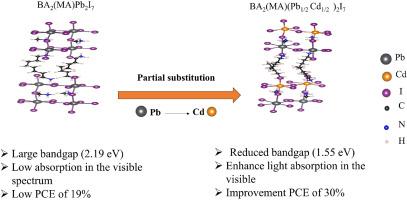用镉部分取代铅,提高铅基准二维Ruddlesden-Popper钙钛矿的光电性能
IF 3.5
3区 化学
Q2 CHEMISTRY, INORGANIC & NUCLEAR
引用次数: 0
摘要
铅基准二维(2DRP)钙钛矿以其可调谐的光电特性、高耐湿性和环境稳定性而闻名。然而,这些钙钛矿表现出宽带隙(Eg),低可见光吸收和高激子结合能,这限制了电荷迁移率,导致光伏效率低。为了解决这些问题,我们提出了一种涉及丁基铵(BA)和甲基铵(MA)阳离子的化学式BA2(MA)(CdxPb(1-x))2I7的策略,其中使用镉(Cd)部分取代铅(Pb)来调节带隙并改善光电性能。利用第一性原理计算,我们的结果表明,镉的掺入诱导了从正交晶型到单斜晶型的转变。这种转变减少了无机层之间的距离,而铅的6s轨道和镉的5s轨道的杂化导致Eg从2.19 eV(纯Pb)逐渐降低到1.81 eV (x = 0.25)和1.55 eV (x = 0.5),从而增强了可见光吸收。此外,反射率从24%降低到17%,同时激子结合能和有效质量降低,从而促进电荷传输。优化后的BA2(MA)(Pb 12 Cd12)2I7厚度小于10 μm,短路电流密度(Jsc)为27 MA /cm2,最大光电转换效率(SLME)为30%,超过了纯铅基钙钛矿(SLME 19%, Jsc 11 MA /cm2)。这些结果表明,在2DRP钙钛矿中用镉部分替代铅是提高光伏性能和开发高效稳定的钙钛矿太阳能电池的一种很有前途的策略。本文章由计算机程序翻译,如有差异,请以英文原文为准。

Enhancing the optoelectronic properties and performance of lead-based quasi-two-dimensional Ruddlesden–Popper perovskites through partial substitution of lead with cadmium for solar cells
Lead-based quasi-two-dimensional (2DRP) perovskites are known for their tunable optoelectronic properties, high moisture resistance, and environmental stability. However, these perovskites exhibit a wide band gap (Eg), low visible light absorption, and high exciton binding energy, which limits charge mobility and results in low photovoltaic efficiency. To address these issues, we propose a strategy involving butylammonium (BA) and methylammonium (MA) cations in the chemical formula BA2(MA)(CdxPb(1-x))2I7, where partial substitution of lead (Pb) with cadmium (Cd) is used to adjust the band gap and improve the optoelectronic properties. Using first-principles calculations, our results show that Cd incorporation induces a transition from orthorhombic to monoclinic crystal structure. This transition reduces the distances between the inorganic layers, while the hybridisation of the 6s orbitals of lead and the 5s orbitals of cadmium leads to a progressive decrease in Eg, from 2.19 eV (pure Pb) to 1.81 eV (x = 0.25) and 1.55 eV (x = 0.5), thus enhancing visible light absorption. Additionally, reflectivity decreases from 24 % to 17 %, along with a reduction in exciton binding energy and effective mass, thus facilitating charge transport. The optimised composition, BA2(MA)(Pb Cd)2I7, with a thickness of less than 10 μm, achieved a short-circuit current density (Jsc) of 27 mA/cm2 and a maximum light-to-electricity conversion efficiency (SLME) of 30 %, surpassing the pure lead-based perovskite (SLME 19 %, Jsc 11 mA/cm2). These results suggest that partial substitution of lead with cadmium in 2DRP perovskites is a promising strategy for enhancing photovoltaic performance and developing efficient and stable perovskite solar cells.
求助全文
通过发布文献求助,成功后即可免费获取论文全文。
去求助
来源期刊

Journal of Solid State Chemistry
化学-无机化学与核化学
CiteScore
6.00
自引率
9.10%
发文量
848
审稿时长
25 days
期刊介绍:
Covering major developments in the field of solid state chemistry and related areas such as ceramics and amorphous materials, the Journal of Solid State Chemistry features studies of chemical, structural, thermodynamic, electronic, magnetic, and optical properties and processes in solids.
 求助内容:
求助内容: 应助结果提醒方式:
应助结果提醒方式:


